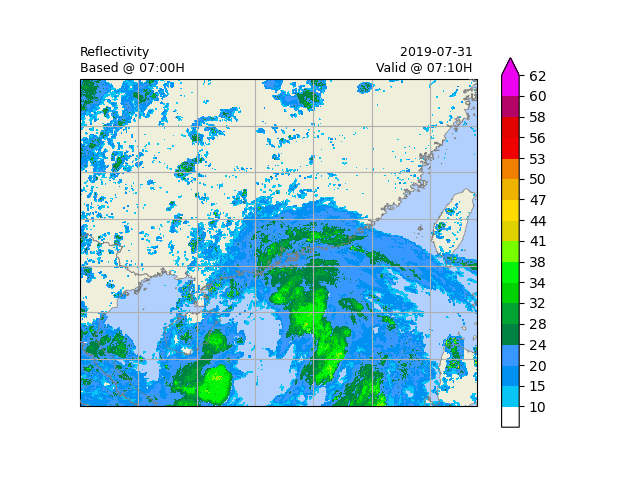Note
Click here to download the full example code
Himawari-8 data
This example demonstrates how to read Himawari-8 data files as reflectivity data.
Definitions
Import all required modules and methods:
# Python package to allow system command line functions
import os
# Python package to manage warning message
import warnings
# Python package for time calculations
import pandas as pd
# Python package for numerical calculations
import numpy as np
# Python package for projection
import cartopy.crs as ccrs
# Python package for land/sea features
import cartopy.feature as cfeature
# Python package for reading map shape file
import cartopy.io.shapereader as shpreader
# Python package for creating plots
from matplotlib import pyplot as plt
# Python package for colorbars
from matplotlib.colors import BoundaryNorm, ListedColormap
# swirlspy h8 parser function
from swirlspy.sat.h8 import read_h8_data
# directory constants
from swirlspy.tests.samples import DATA_DIR
from swirlspy.tests.outputs import OUTPUT_DIR
warnings.filterwarnings("ignore")
plt.switch_backend('agg')
start_time = pd.Timestamp.now()
Initialising
This section demonstrates parsing Himawari-8 data.
Step 1: Define necessary parameter.
# Define base time
base_time = pd.Timestamp("2019-07-31T07:00")
# Define data boundary in WGS84 (latitude)
latitude_from = 30.
latitude_to = 16.
longitude_from = 105.
longitude_to = 122.
area = (
latitude_from, latitude_to,
longitude_from, longitude_to
)
# Define grid size, use negative value for descending range
grid_size = (-.025, .025)
Step 2: Define data directory
# Supply data directory.
# Please make sure H8 data filename is follow the naming pattern -
# HS_H08_{date}_{time}_B{channel:02}_FLDK_R{rsol:02}_S{seg:02}10.DAT
# example:
# base time = 2019-07-31 07:00 UTC
# channel = 4
# resolution = 10
# segment = 2
# ========================================
# filename: HS_H08_20190731_0700_B04_FLDK_R10_S0410.DAT
data_dir = os.path.join(DATA_DIR, "h8")
initialising_time = pd.Timestamp.now()
Step 3: Parse data into reflectivity as xarray.DataArray using read_h8_data().
reflec = read_h8_data(
data_dir,
base_time,
area,
grid_size
)
sat_time = pd.Timestamp.now()
Step 4: Remove invalid data if needed. **those data may be useful during post process, so this step is optional.
reflec.values[reflec.values < 13.] = reflec.attrs['zero_value']
sat_post_time = pd.Timestamp.now()
Generating radar reflectivity maps
Define the color scale and format of the plots and plot using xarray.plot().
In this example, only hourly images will be plotted.
# Defining colour scale and format
levels = [
-32768,
10, 15, 20, 24, 28, 32,
34, 38, 41, 44, 47, 50,
53, 56, 58, 60, 62
]
cmap = ListedColormap([
'#FFFFFF', '#08C5F5', '#0091F3', '#3898FF', '#008243', '#00A433',
'#00D100', '#01F508', '#77FF00', '#E0D100', '#FFDC01', '#EEB200',
'#F08100', '#F00101', '#E20200', '#B40466', '#ED02F0'
])
norm = BoundaryNorm(levels, ncolors=cmap.N, clip=True)
# Defining the crs
crs = ccrs.PlateCarree()
# Defining coastlines
map_shape_file = os.path.join(DATA_DIR, "shape/rsmc")
ocean_color = np.array([[[178, 208, 254]]], dtype=np.uint8)
land_color = cfeature.COLORS['land']
coastline = cfeature.ShapelyFeature(
list(shpreader.Reader(map_shape_file).geometries()),
ccrs.PlateCarree()
)
# Plotting
f = plt.figure()
ax = plt.axes(projection=crs)
ax.set_extent((
longitude_from, longitude_to,
latitude_from, latitude_to
), crs=crs)
# ocean
ax.imshow(np.tile(ocean_color, [2, 2, 1]),
origin='upper',
transform=ccrs.PlateCarree(),
extent=[-180, 180, -180, 180],
zorder=-1)
# coastline, color
ax.add_feature(coastline,
facecolor=land_color, edgecolor='none', zorder=0)
# overlay coastline without color
ax.add_feature(coastline, facecolor='none',
edgecolor='gray', linewidth=0.5, zorder=3)
ax.gridlines()
reflec.where(reflec != reflec.attrs['zero_value']).plot(
ax=ax,
cbar_kwargs={
'extend': 'max',
'ticks': levels[1:],
'format': '%.3g'
},
cmap=cmap,
norm=norm
)
ax.set_title(
"Reflectivity\n"
f"Based @ {base_time.strftime('%H:%MH')}",
loc='left',
fontsize=9
)
ax.set_title(
''
)
ax.set_title(
f"{base_time.strftime('%Y-%m-%d')} \n"
f"Valid @ {(base_time + pd.Timedelta(minutes=10)).strftime('%H:%MH')} ",
loc='right',
fontsize=9
)
plt.savefig(
os.path.join(OUTPUT_DIR, "h8.png"),
dpi=300
)
sat_image_time = pd.Timestamp.now()

Checking run time of each component
print(f"Start time: {start_time}")
print(f"Initialising time: {initialising_time}")
print(f"H8 data parsing time: {sat_time}")
print(f"Post H8 data processing time: {sat_post_time}")
print(f"Plotting sat image time: {sat_image_time}")
print(f"Time to initialise: {initialising_time - start_time}")
print(f"Time to run data parsing: {sat_time - initialising_time}")
print(f"Time to perform post process: {sat_post_time - sat_time}")
print(f"Time to plot reflectivity image: {sat_image_time - sat_post_time}")
Start time: 2026-01-03 10:54:36.485301
Initialising time: 2026-01-03 10:54:36.485862
H8 data parsing time: 2026-01-03 10:54:41.276586
Post H8 data processing time: 2026-01-03 10:54:41.278439
Plotting sat image time: 2026-01-03 10:54:43.174084
Time to initialise: 0 days 00:00:00.000561
Time to run data parsing: 0 days 00:00:04.790724
Time to perform post process: 0 days 00:00:00.001853
Time to plot reflectivity image: 0 days 00:00:01.895645
Total running time of the script: ( 0 minutes 6.930 seconds)